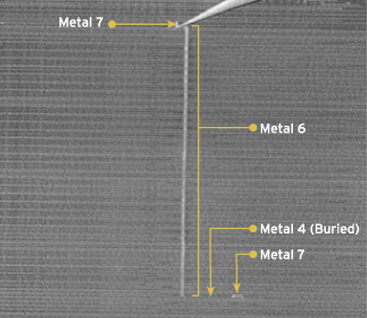|
| A colorized EBAC image
overlaid on an SEM image.
This package is the complete solution for Electron Beam
Induced Current (EBIC) and Electron Beam Absorbed Current
(EBAC) characterization. A host of failures in today’s
devices can be attributed to mismatched doping concentrations,
misplaced dopants, opens, and shorts. These failure mechanisms
can be located and characterized using the E-Beam Current
(EBC) Analysis Package. The package consists of a two stage
ultra high gain amplification system, an E-Beam scan control
system, cables, and interface hardware (for your specific
SEM), and a software interface to contol it all.
The included
E-Beam scan control system allows for ultimate flexibility
in digital E-Beam control. A dual input feature
allows the EBIC/EBAC signal and another imaging signal,
such as a secondary electron detector, to be acquired and
displayed
simultaneously. The user is able to collect ultra-high
resolution images through the scan control system for further
image
processing.
Both a real time and post processing digital
zoom function allows increased magnification without altering
SEM magnification.
Post acquisition line profiles can be extracted from
maps for advanced analysis with a choice of multiple autoscaling
routines, a histogram tool, and user defined or predefined
intensity look-up tables. Post image processing capability
also includes false colorization and image overlay, as
well as, a wide range of mathematical functions which
can be applied to the images and data set.
The EBIC technique uses the E-beam to induce a charge into
a PN junction. A pre-amplifier is connected to the sample
stage or a probe tip and an image is gathered through this
channel as the E-beam rasters across the sample. The resulting
image is then mixed with the secondary electron detector
image and yields varying contrast between the P and N regions.
The dopant concentration and any irregularities are now characterized.
The EBAC technique is similar to EBIC, but is used on metal
lines and buried vias. During EBAC characterization, the
metal line absorbs current from the E-beam. A probe is connected
to the line and again routes through a pre-amplifier to capture
an image as the E-beam rasters across the sample.

| EBAC
Signal mixed with SEM signal to pinpoint opens in buried
metal lines.
|
Note the sample is only depreocessed to Metal
7.
This can be done on a metal line on the surface and it
will yield a quantitative active voltage contrast image. The technique
is more powerful than traditional AVC, since it allows
you to locate and characterize buried faults up to four
layers down. A line can be contacted at metal layer 4 and
an image can be captured of that same line at layer 3 and 2. The EBC
Package is highly sensitive and can detect small currents
from the metal line through the dielectric. By increasing
the beam voltage a user can image deeper into the sample.
Shorts and opens are located before destructive deprocessing
eliminates the ability to detect them. |


